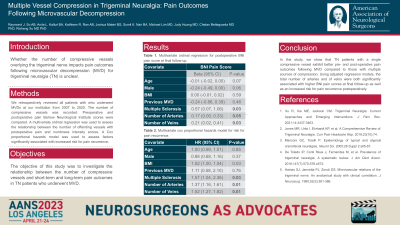Multiple vessel compression of the trigeminal nerve is associated with worse outcomes in trigeminal neuralgia following microvascular decompression
Multiple Vessel Compression of the Trigeminal Nerve Is Associated with Worse Outcomes in Trigeminal Neuralgia Following Microvascular Decompression
Friday, April 21, 2023


Raymond J. So, AB (he/him/his)
Medical Student
Johns Hopkins University School of Medicine
ePoster Presenter(s)
Introduction: Although the precise etiology and pathophysiology of trigeminal neuralgia (TN) are still incompletely understood, vascular compression of the trigeminal nerve is thought to be a common cause of TN and has been estimated to account for nearly 80% of cases. Whether the total number of compressive vessels impacts pre- and post-surgical pain outcomes in TN remains unclear.
Methods: We retrospectively reviewed all patients with TN who underwent MVDs at our institution from 2007-2020. The number and identity of compressive vessels on the trigeminal nerve were recorded. A Mann-Whitney U test was used to compare pre-operative and post-operative Barrow Neurological Institute (BNI) pain and numbness scores. A multivariate ordinal regression was used to assess the relationship between the number of offending arteries and veins with post-operative BNI pain and numbness intensity scores. A Cox proportional hazards model was used to assess factors significantly associated with increased risk for time to pain recurrence.
Results: We identified 496 patients with a single vessel and 381 patients with multiple vessels compressing the trigeminal nerve. Compared to patients with a single compressive vessel, patients with multiple sources of compression exhibited increased BNI pain scores pre-operatively (p=0.01). Additionally, pain recurrence was more frequent (p < 0.001) and occurred after a significantly shorter pain-free duration (p < 0.001) for the multiple compression group. Using multivariate ordinal regression, a greater number of arteries (p=0.03) and veins (p=0.03) were both significantly associated with higher pain scores at final follow-up. Furthermore, the number of arteries (p=0.01) and of veins (p=0.01) was significantly associated with a higher risk for pain recurrence.
Conclusion : TN patients with a single compressive vessel exhibited better pain outcomes following MVD. Patients with multiple compressive vessels exhibited higher pain scores pre-operatively and incurred a higher risk for pain recurrence, which occurred after a shorter pain-free interval compared to the single compression cohort.
Methods: We retrospectively reviewed all patients with TN who underwent MVDs at our institution from 2007-2020. The number and identity of compressive vessels on the trigeminal nerve were recorded. A Mann-Whitney U test was used to compare pre-operative and post-operative Barrow Neurological Institute (BNI) pain and numbness scores. A multivariate ordinal regression was used to assess the relationship between the number of offending arteries and veins with post-operative BNI pain and numbness intensity scores. A Cox proportional hazards model was used to assess factors significantly associated with increased risk for time to pain recurrence.
Results: We identified 496 patients with a single vessel and 381 patients with multiple vessels compressing the trigeminal nerve. Compared to patients with a single compressive vessel, patients with multiple sources of compression exhibited increased BNI pain scores pre-operatively (p=0.01). Additionally, pain recurrence was more frequent (p < 0.001) and occurred after a significantly shorter pain-free duration (p < 0.001) for the multiple compression group. Using multivariate ordinal regression, a greater number of arteries (p=0.03) and veins (p=0.03) were both significantly associated with higher pain scores at final follow-up. Furthermore, the number of arteries (p=0.01) and of veins (p=0.01) was significantly associated with a higher risk for pain recurrence.
Conclusion : TN patients with a single compressive vessel exhibited better pain outcomes following MVD. Patients with multiple compressive vessels exhibited higher pain scores pre-operatively and incurred a higher risk for pain recurrence, which occurred after a shorter pain-free interval compared to the single compression cohort.
